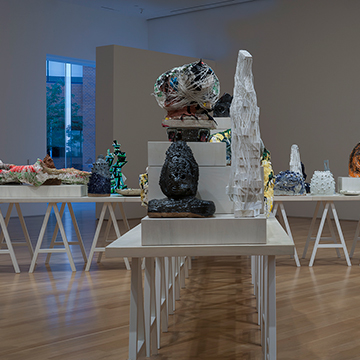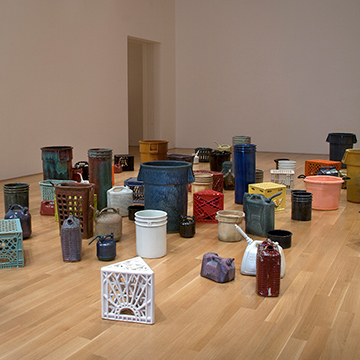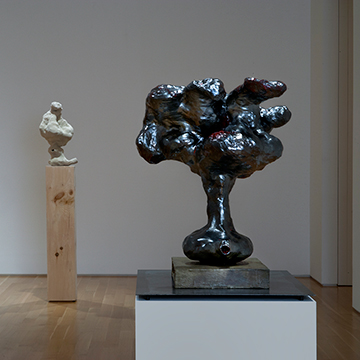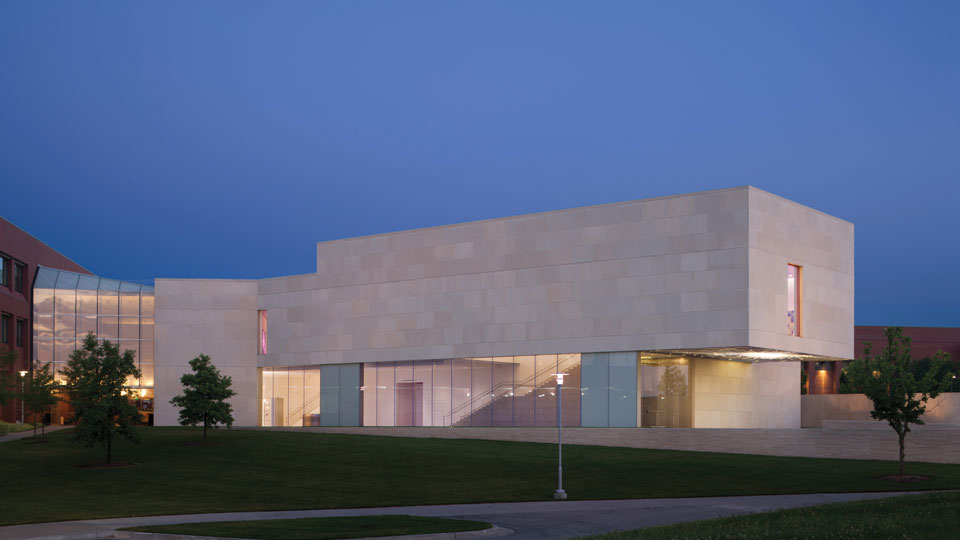.SUM
Matthias Merkel Hess · William J. O'Brien · Arlene Shechet
Artists Matthias Merkel Hess, William J. O’Brien, and Arlene Shechet each employ clay as a sculptural medium for their respective works. In addition, site-specific installations are a critical aspect of each artist’s practice. For .SUM, Merkel Hess, O’Brien, and Shechet were invited by the Nerman Museum to each create an installation for one of the museum’s first floor galleries.
Los Angeles artist Mathias Merkel Hess’ Bucketry II is the artist’s largest installation to date. Pseudo-functional sculpture, his works nod to clay’s old confinement to the ghetto of useful craft, but they also bring to mind some of the oldest and most treasured artifacts of humankind, vessels for carrying water and storing grain. Merkel Hess has taken the new, plastic, mass produced, cheap versions of those containers and made them double back into something semi-precious and handmade. His hand-built sculptures faithfully mimic mass-produced objects: trash cans (particularly Rubbermade Brute), milk crates, laundry baskets, buckets, gas cans and beverage coolers. He’s endowed the generic and uniform with character, irregular grace, and a sense of humor.
Chicago-based artist William J. O’Brien is best known for his riotous tableaux of ceramic, metal, and mixed media
sculptures. The accumulation of objects for his installation, Untitled (X), echoes the controlled mayhem of his studio – a place, the artist has said where he is compelled to work in a nearly compulsive way. O’Brien’s sculptural tableaux blends many hybrid precursors to create an immersive installation – a complex arrangement in which sources such as African masks, funerary monuments, modernist sculpture, and the more contemporary embrace of textiles and ceramics coalesce. It is a powerful evocation of the vibrant past of a so-called “decorative” art, whose legacy, in O’Brien’s hands, becomes a rich embodiment of the vast and polyglot history of sculpture and ceramics for the pluralist 21st century.
A New York studio-based artist, Arlene Shechet, has been making sculptures for over two decades. And, while Shechet found clay to be her primary medium some six years ago, her most recent works demonstrate a shift toward a new body of dynamic forms that stretch the limits of her material and reveal her ongoing exploration of imperfection and impermanence and function as a vehicle for transformation, vulnerability, and grace. Her works on view precariously defy their own weight, leaning against themselves, opening interiors in spouts and drips, coiling with energetic fecundity in luscious glazes and stoically seated objects that seem to reach in multiple directions at once. As paradoxical forms – simultaneously awkward and self-supporting – they demonstrate a poetic relationship to the nature of human experience in all its imperfections and miraculous possibility.





